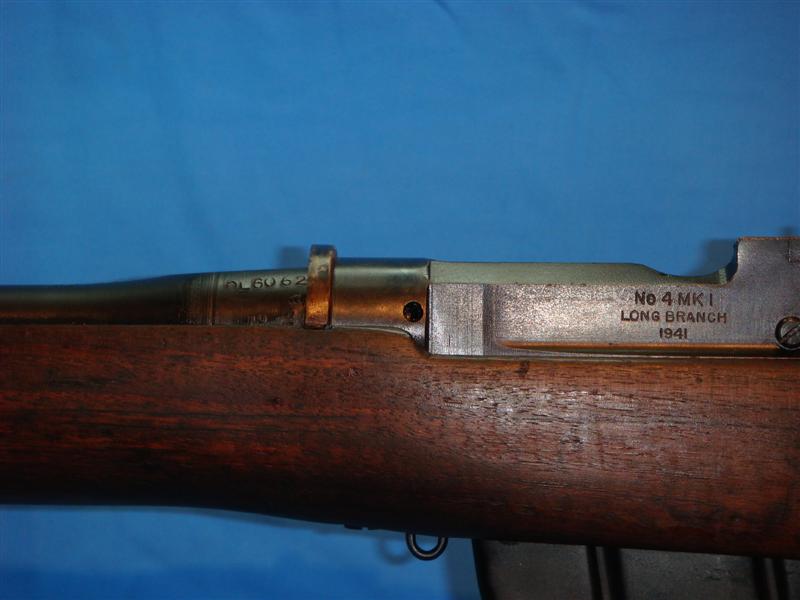-
Note the two shallow, angled machine tool marks on the left hand side of both action bodies, about ~3" ahead of the ejector screw. Pretty distinctive. It surely indicates the example shown by Badger hasn't been "scrubbed clean" of markings. The flats just to the rear of the receiver rings appears to be pretty close in texture, depth and profile, too.
The finish seems distinctive, somehow, as well.
However, the two butt sockets appear quite different in detail- at least on the left side. Oddly, the finish on EX 11 seems to have had more "clean-up" than E-X 2's in this region.
Done gone plumb 'nerd" on y'all , I reckon! Sorry- it does nothing to define their historical import...
Sorry- it does nothing to define their historical import...
ETA:Oy, buffdog, what's the date of the article?
Last edited by jmoore; 05-27-2011 at 04:50 PM.
-
-
05-27-2011 04:46 PM
# ADS
Friends and Sponsors

-
FREE MEMBER
NO Posting or PM's Allowed

Date of Article
The date was late 1941. I will see if I can find it again. Hamilton Spectator newspaper, Hamilton, Ontario, Canada .
.
.
-
-
Advisory Panel


My own view is that the "EX" marks were added some time after the receivers were made: the receivers are well-finished (at least EX11, which I examined in some detail), whereas the EX marks are roughly struck. I'd guess that the receivers were pilot production or gauging samples from the (then) new Long Branch production line, and that they were initially stored or held as reference samples. Later on, they would have provided a convenient pool of top-quality receivers suitable for use as test-beds in trials or experiments.
-
Thank You to Thunderbox For This Useful Post:
-
Does anyone have a photo of the milled flat just behind the barrel reinforce ring LH side on a Long Branch "0L" or "1L" (pre- Mk.1*) series rifle?
That area looks a lot different on 3L2888.
Complete tooling change (Probably cam driven profiler) would be VERY odd, this early on. Toolroom preproduction samples or ??? seem quite likely, as Thunderbox and Peter Laidler surmise above.
surmise above.
Last edited by jmoore; 05-30-2011 at 09:01 AM.
-
-
-
Thank You to Badger For This Useful Post:
-
-
-
You can see the same with Daimler Bren gun bodies too JM. Downcut milling against up cut - even when the cutters desperately need changing! I saw one recently where from the dire state of the cut finish, the poor machine must have been crying out for the tool setter to come along
-
-
More grist to the mill...
Life would certainly be dull if one knew everything!
Rather than trying to fit the item into a particular pigeon hole, we should consider all relevant information and the photos first, before coming to a conclusion.
In my opinion, the most pertinent posts from Peter Laidler , Thunderbox and Buffdog to Badger's observations.
, Thunderbox and Buffdog to Badger's observations.
1. EX (why should it be considered experimental, and then draw features to explain it?). There does not seem to be anything experimental there.
2. EX 11 is BNP (British Nitro Proof) marked, thus exported out of England post-war.
post-war.
3. EX 2 (and to a lesser extent EX 11) has early features... Mk I action, Mk I (Singer) rearsight, original style safety lever, 'button' cocking piece, magazine & trigger guard.
4. EX 2 does not appear to have Long Branch factory, year & mark designation on the left wall of the action body.
5. Wood on EX 11 is certainly a show grade but there is little doubt that the butt extension & aperture plate mod. were post disposal.
6. EX 2 butt marking disc has chamfered edges, like a presentation or sample specimen.
7. Was the top of the safety lever on EX 11 removed post disposal, or was that original?
8. Early Canadian timber, early brass buttplates.
timber, early brass buttplates.
So what can we assume from the above (there would be more likely if we had closer shots of EX 2)?
a. Early production of both rifles, even earlier apparent for EX 2.
b. EX 11 has been to England and back.
c. More likely exhibition models or show examples than experimentals.
d. Both rifles show post-disposal use, from wear marks on the stock of EX 2 and rifle range swivel, extended butt & plate fitting for EX 11.
e. From the fittings, EX 2 is likely earlier date production than EX 11. Why does the EX prefix necessarily make them from the same batch?
I would offer an opinion from the above that they are not experimental models, rather show or exhibition specimens. From memory, there are one or two EX prefix rifles in the Faris collection although I would need to dig through lots of old notes to see if they are relevant.
One thing is for certain, the more one learns, the more we realise that we don't know.
Ian
-
The Following 6 Members Say Thank You to Ian Skennerton For This Useful Post:
-
Legacy Member

"It's a lovely rifle and has a .303 magazine cleverly modified internally to feed 7.62 rounds. "
Brian do you have a picture or description. Slightly off topic but very interesting all the same.
-
-
FREE MEMBER
NO Posting or PM's Allowed

Not to hijack the thread but...
I have a question about the "oil-burnt" finish on Thunderbox's rifle EX11. How is this finish done? I've tried searching it on the internet and all I've found is burnt oil finishes for metal, not wood. Any help would be greatly appreciated.
Cheers!
Sorry- it does nothing to define their historical import...

















 PM
PM













